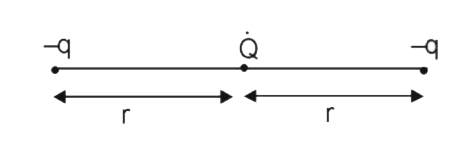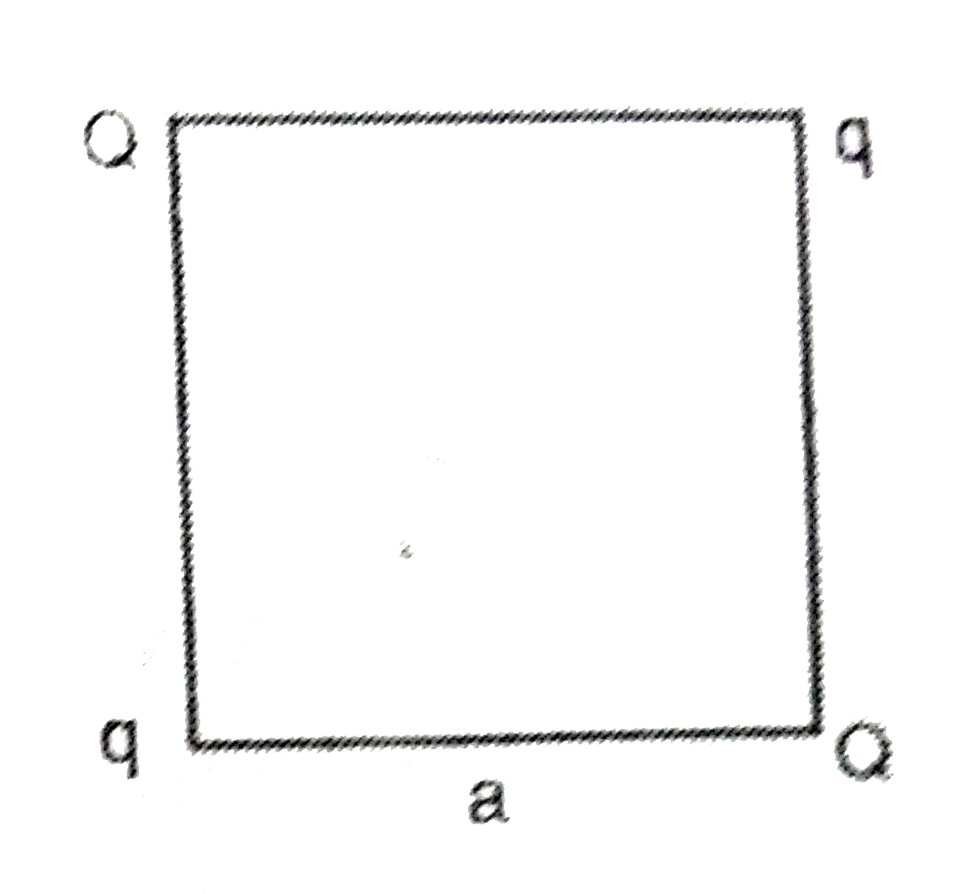Three point charges q, 2q and 8q are to be placed on a
. 9cm long straight line. Find the
. positions where the charges shouldbe placed such that the potential energy
. of this sysrem is minimum. In this situation, what is the
. electric field at the charge q due to the other two charges?
To solve the problem of placing three point charges q, 2q, and 8q on a 9 cm long straight line such that the potential energy of the system is minimized, we can follow these steps:
Step 1: Understanding the Configuration
We have three charges:
- Charge q (let's denote it as Q)
- Charge 2q (denote it as 2Q)
- Charge 8q (denote it as 8Q)
We need to place these charges along a straight line of length 9 cm.
Step 2: Positioning the Charges
To minimize the potential energy, we should place the smaller charge Q between the larger charges 2Q and 8Q. This is because the potential energy is inversely proportional to the distance between the charges, and we want to maximize the distance between the larger charges.
Let:
- The distance from 2Q to Q be x cm.
- The distance from Q to 8Q will then be 9−x cm.
Step 3: Writing the Expression for Potential Energy
The total potential energy U of the system can be expressed as the sum of the potential energies between each pair of charges:
U=kQ⋅2Qx+kQ⋅8Q9−x+k2Q⋅8Q9
Where k is Coulomb's constant.
Step 4: Simplifying the Expression
Substituting the values, we get:
U=kQ2(2x+89−x+169)
We can ignore the constant kQ2 for the purpose of minimizing U.
Step 5: Finding the Minimum Potential Energy
To find the value of x that minimizes U, we differentiate U with respect to x and set the derivative to zero:
dUdx=−2x2+8(9−x)2=0
Cross-multiplying gives:
2(9−x)2=8x2
Expanding and simplifying:
2(81−18x+x2)=8x2
162−36x+2x2=8x2
6x2−36x+162=0
Dividing the entire equation by 6:
x2−6x+27=0
Using the quadratic formula:
x=6±√(−6)2−4⋅1⋅272⋅1
x=6±√36−1082
x=6±√−722
Since we have a negative discriminant, we need to check our earlier steps or assumptions.
Step 6: Correcting the Approach
Given the configuration, we can assume:
- Q is at x=3 cm.
- 2Q is at 0 cm.
- 8Q is at 9 cm.
Step 7: Electric Field Calculation at Charge Q
Now, we need to calculate the electric field at the position of charge Q due to the other two charges 2Q and 8Q.
1. Electric Field due to 2Q:
E2Q=k⋅2Q(3)2=2kQ9
This field points towards 2Q (to the left).
2. Electric Field due to 8Q:
E8Q=k⋅8Q(6)2=8kQ36=2kQ9
This field points away from 8Q (to the right).
Step 8: Net Electric Field at Charge Q
The net electric field Enet at charge Q is:
Enet=E2Q−E8Q=2kQ9−2kQ9=0
Final Answer
Thus, the positions of the charges for minimum potential energy are:
- 2Q at 0 cm
- Q at 3 cm
- 8Q at 9 cm
The electric field at charge Q due to the other two charges is:
Enet=0
We have three charges:
- Charge q (let's denote it as Q)
- Charge 2q (denote it as 2Q)
- Charge 8q (denote it as 8Q)
To minimize the potential energy, we should place the smaller charge Q between the larger charges 2Q and 8Q. This is because the potential energy is inversely proportional to the distance between the charges, and we want to maximize the distance between the larger charges.
- The distance from 2Q to Q be x cm.
- The distance from Q to 8Q will then be 9−x cm.
The total potential energy U of the system can be expressed as the sum of the potential energies between each pair of charges:
U=kQ⋅2Qx+kQ⋅8Q9−x+k2Q⋅8Q9
Where k is Coulomb's constant.
Substituting the values, we get:
U=kQ2(2x+89−x+169)
We can ignore the constant kQ2 for the purpose of minimizing U.
To find the value of x that minimizes U, we differentiate U with respect to x and set the derivative to zero:
dUdx=−2x2+8(9−x)2=0
Cross-multiplying gives:
2(9−x)2=8x2
Expanding and simplifying:
2(81−18x+x2)=8x2
162−36x+2x2=8x2
6x2−36x+162=0
Dividing the entire equation by 6:
x2−6x+27=0
Using the quadratic formula:
x=6±√(−6)2−4⋅1⋅272⋅1
x=6±√36−1082
x=6±√−722
Since we have a negative discriminant, we need to check our earlier steps or assumptions.
Given the configuration, we can assume:
- Q is at x=3 cm.
- 2Q is at 0 cm.
- 8Q is at 9 cm.
Now, we need to calculate the electric field at the position of charge Q due to the other two charges 2Q and 8Q.
E2Q=k⋅2Q(3)2=2kQ9
This field points towards 2Q (to the left).
E8Q=k⋅8Q(6)2=8kQ36=2kQ9
This field points away from 8Q (to the right).
The net electric field Enet at charge Q is:
Enet=E2Q−E8Q=2kQ9−2kQ9=0
Thus, the positions of the charges for minimum potential energy are:
- 2Q at 0 cm
- Q at 3 cm
- 8Q at 9 cm
Enet=0
Topper's Solved these Questions
- ELECTRIC FIELD AND POTENTIALBOOK - HC VERMACHAPTER - ELECTRIC FIELD AND POTENTIALEXERCISE - Short Answer
14 Videos
- ELECTRIC FIELD AND POTENTIALBOOK - HC VERMACHAPTER - ELECTRIC FIELD AND POTENTIALEXERCISE - Objective 1
9 Videos
- ELECTRIC FIELD AND POTENTIALBOOK - HC VERMACHAPTER - ELECTRIC FIELD AND POTENTIALEXERCISE - Exercises
75 Videos
- ELECTRIC CURRENT THROUGH GASESBOOK - HC VERMACHAPTER - ELECTRIC CURRENT THROUGH GASESEXERCISE - Exercises
23 Videos
- ELECTROMAGNETIC INDUCTIONBOOK - HC VERMACHAPTER - ELECTROMAGNETIC INDUCTIONEXERCISE - EXERCISE
9 Videos
Similar Questions
Three charges Q, 2Q, 8Q are to be placed on a line whose length is R metre. Lacate the positive where these charges should be placed such that the potential energy of the system is minimum.
View SolutionThree point charges +q, +2q and Q are placed at the three vertices of an equilateral triangle. Find the value of charge Q (in terms of q), so that electric potential energy of the system is zero.
View Solution
Knowledge Check
Three point charge Q,4Q and 16Q are placed on a straight line 9cm long.Charges are placed in such a way that the system has minimum potential energy .Then
A4Q and 16Q must be at the ends and Q at a distance of 3 cm from the 16QB4Q and 16Q must be at the ends and Q at a distance of 3 cm from the 16QCElectric field at the position of Q at a distance of 6cm from the 16Q.DElectric field at the position of Q at a distance of 6cm from the 16Q.Charges 2q and 8q are placed at the end points A and B repsectively of a 9cm long straight line. A third charge q is placed at a point CofAB such that the potential energy of the system is minimum . The distance of C from A is
A2cmB3cmC4cmD5cmTwo point charges 2q and 8q are placed at a distance r apart. Where should a third charge −q be placed between them so that the electrical potential energy of the system is a minimum
Aat a distance of r/3 from 2qBat a distance of 2r/3 from 2qCat a distance of r/16 from 2qDNone of the above
Three charges are placed as shown in fig if the electric potential energy of system is zero, then Q : q-

View SolutionFour point charges Q, q, Q and q are placed at the corners of a square of side' a' as shown in the figure.
Find the .
(a) resultnat electric force on a charge Q and .
(b) potential energy of this system.

View SolutionTwo electric charges q1=qandq2=−2q are placed at a distance l = 6a apart. Find the locus of points in the plane of the charges where the field potential is zero
View SolutionThree point charge Q,4Q and 16Q are placed on a straight line 9cm long.Charges are placed in such a way that the system has minimum potential energy .Then
View SolutionTwo point charges +4q and +q are placed 30cm apart. At what point on the line joining them is the electric field zero
View Solution

